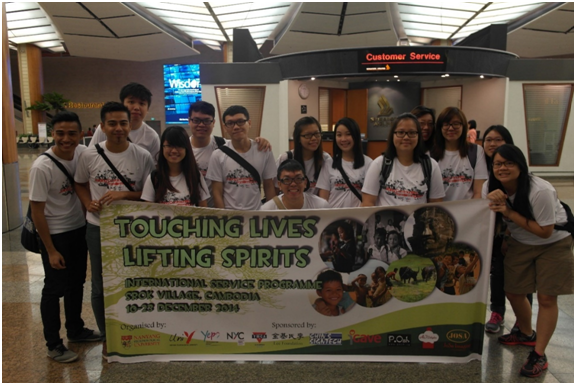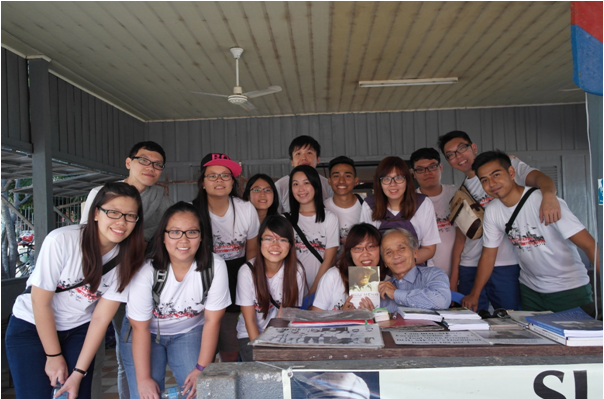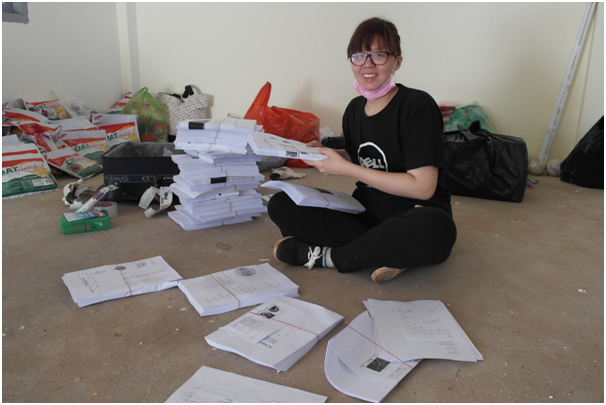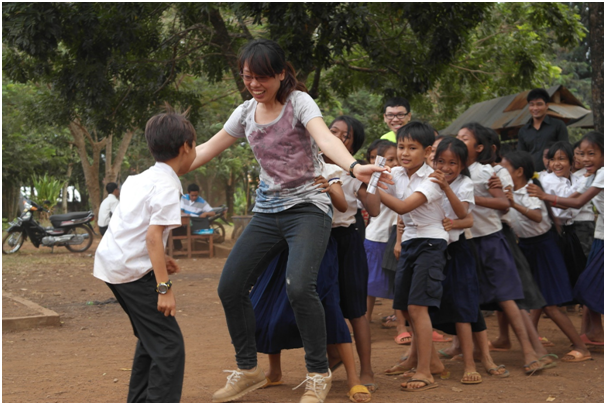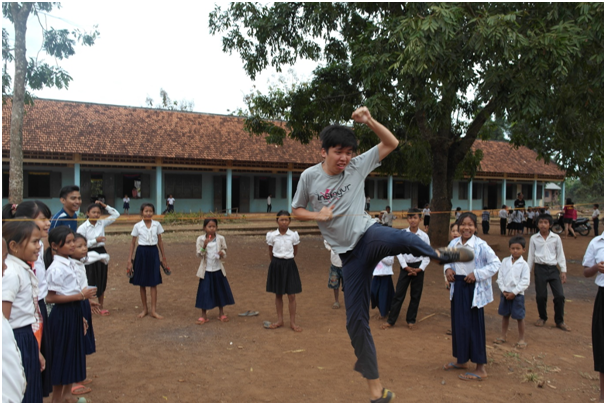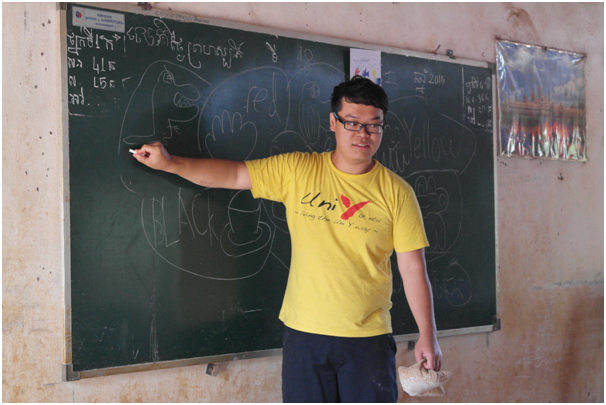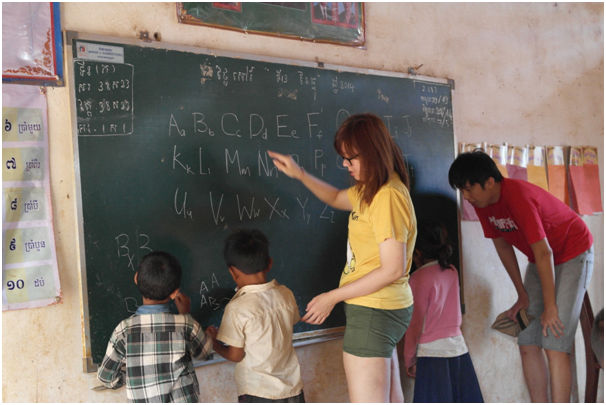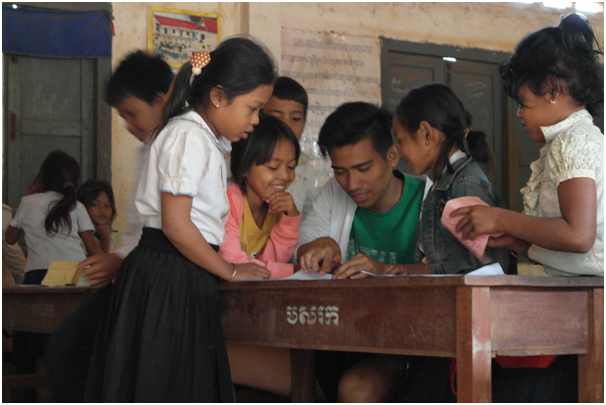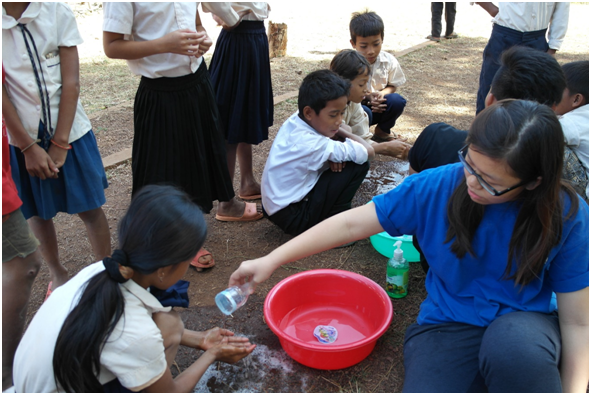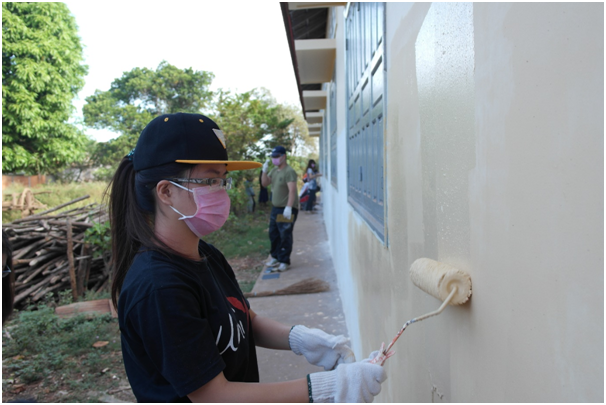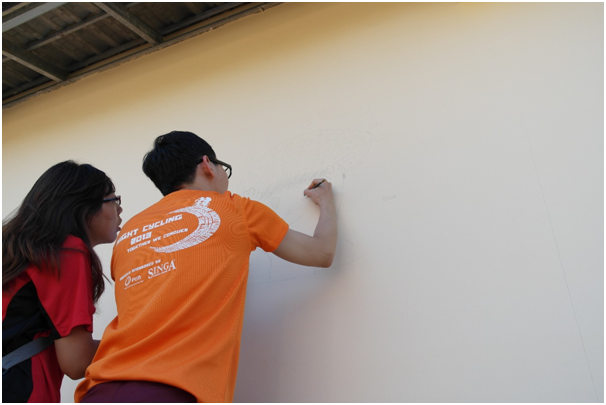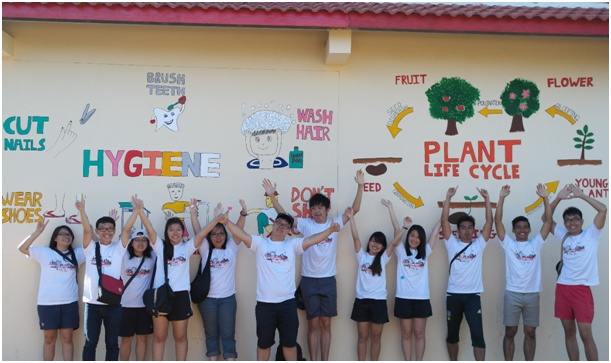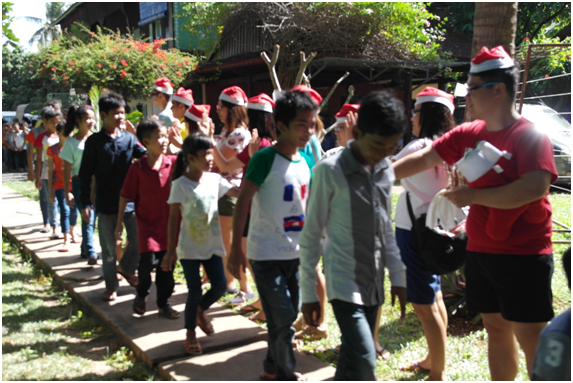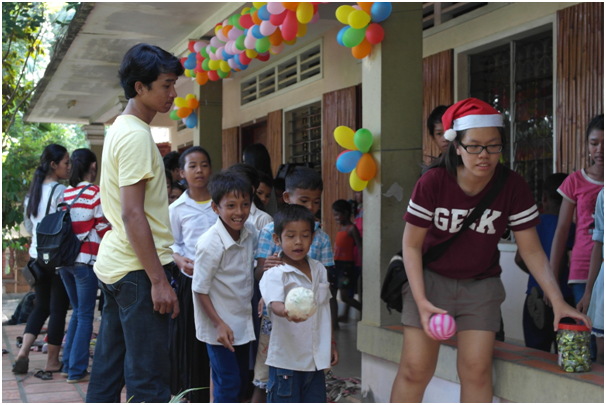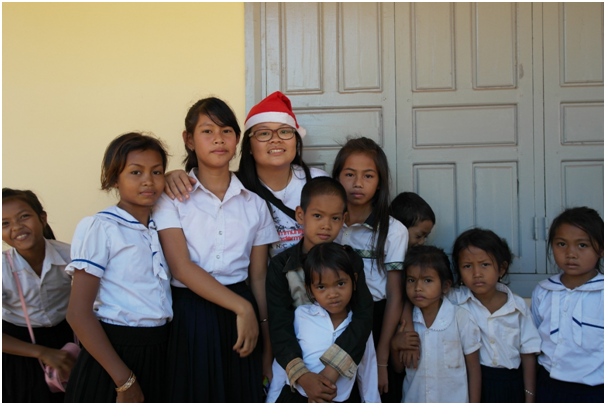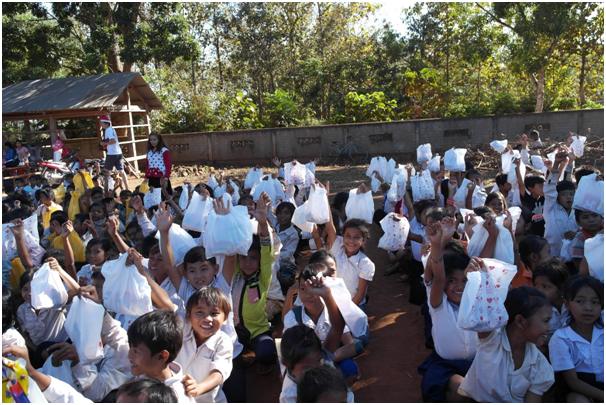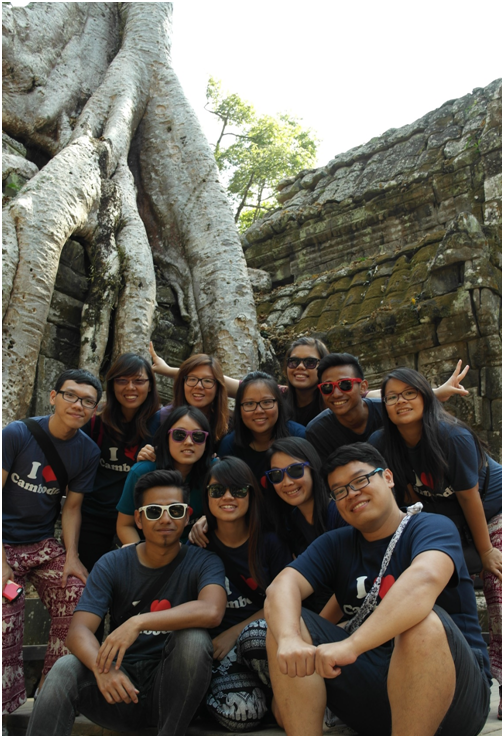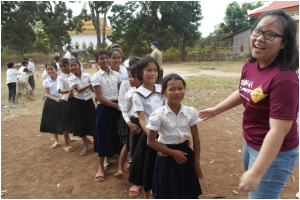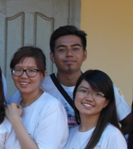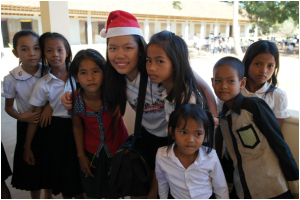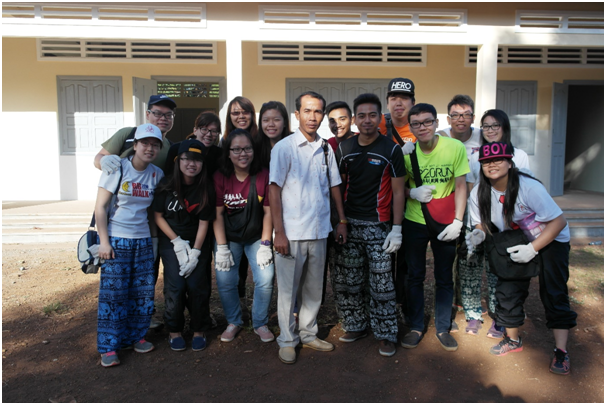Visit to killing field & Genocide Museum
Our trip begin off in Phnom Penh with visitation first on the list. Participants were brought around to visit the killing field and Genocide Museum. This allowed participants to have basic knowledge on the culture and history of the cambodians they are about to serve. It also acts as a buffer for participants to adapt to the climate and to experience the differences of the culture or environment that they will expect to come.
Service at Srok Primary School
Following the visitation in Phnom Penh, we journey to our main service site Srok Village, Kampong Cham, which is about 4-5 hours away from Phnom Penh. Service at Srok Village was a routine work of teaching and construction. The team will have to teach 2 hours in the morning, and 2 hours in the afternoon, while the rest of the service time was spent on construction. As six classes (Grade 1 to 6) had to be conducted at each point in time, the group were divided into 6 small groups 5 each to be allocated to one classroom. On a daily basis, service lasted from 0900-1800hrs. Participants were given time to prepare for their lessons each day. In addition, facilitation/debriefing such as sharing, “angel and mortal” and “pigeon hole” were conducted every night by the leaders. This allows participants to learn from each other experience, gain valuable feedback and encourage one another to walk this journey together.
Teaching in the school
In their groups of 2 to 3, participants were given the task to teach English using the lesson plans that we planned and the worksheet that we had printed for the children to do. At the beginning, different groups experienced different problems; such as unable to complete their lessons for the lower primary classes due to the different English standards across the classes, and most of them found it a challenge to express and put across their lesson to the children due to the language barrier.
However, with facilitation done every night, it allowed participants to share and gain knowledge on how to improve themselves. They managed to adjust the lesson plans to suit the need of their own classes. They also overcome the language barrier by engaging the teacher to help them, by using more drawings as well as learning the basic Khmer phrases such as asking them to write the lesson taught in their book. They also get students to participate by asking them to volunteer to come to the board to write down / recap what they had learnt. To ensure that the students understood what they have taught, worksheets were given out and participants took the effort and time to checked on every student’s work and correct them if necessary.
During one of the lessons, the team decided to bring across the important of hygiene, hence we incorporarted a hygiene lesson as one of our lesson. The team bought hand soap and pails, where we washed the hands of every single students, and taught them the proper steps of washing hands.
Construction
With regards to infrastructure, we was tasked to paint the new build secondary school and to paint murals on the wall of the new secondary school. The building of the new secondary school was an initiative spear headed by a Catholic church in Kampong Cham and YMCA. It was built to help the children in Srok Village to further educate themselves, as children in Srok usually stops their education level at primary school, as the nearest secondary school was about 2 hours away, and the road to the school was not well-established. Majority of the participants are doing painting for the first time, and it allows participants to step out of their comfort zone to serve in other different ways. Safety was ensured with participants assigned with different tasks such as safety officer. Wearing of pants, gloves and covered shoes were also mandatory to reduce physical injuries. Masks were provided as well when the dust got thick and unhealthy.
The team came out with two mural designs, being the life cycle of a plant and hygience education, which the principal was very pleased with the two designs, and requested us to paint both design on the wall as he could not decide on one. Hence, we splitted the group equally into two teams to draw and paint the two different murals, each team being led by a participant that volunteer to step up. The painting of the murals allows participant to find the strengths of each other, where some are better in drawing and some are good in mixing of colours. It also allows participants to build their confident, as most of them was reluctant to do it, as they are not confident in drawing and painting. The team encourages one another, and affirm each other work to help build the confident of one another, and also discovers a talent that they never think they could ever do it.
Rice – Soup Programme
Rice soup programme was held on the 5th day of service, where we travel out to Kampong Cham from our main service site, Srok Village. Kampong Cham is the nearest city from Srok Village, which takes an hour to reach Kampong Cham. This programme is organised by the local church to feed those who have no means of supporting themselves around the outskirts of the city.
Our team first headed to a cooking school own by the church, which teach baking skills to the underpriviledge children. The team has to prepared 200 sets of sandwiches for the children. The team was divided into two teams, where one team was incharge to fry the eggs and sauages using the charcoal stoves, and the other team to pack the sandwiches.
When the sandwiches were ready, we went to the church which is two doors away, and we started preparing for the Christmas carnival prepare for the children, where we set up 9 stations and the children will rotated among the different stations in their groups.
The carnival started with performance from the different outskirts or village which they have prepared, and in return we perform the song “Home”. The booth started after all the performances.
Having 9 stations, with a team of 14, resulted in each station having only 1-2 people to manage. The shortage of manpower resulted in crowd control issues, even though we have assigned to crowd control in-charge. The station master could not take control of their own station as they have to look out for the games and the crowd. The station master could not get the children to queue in an orderly manner was partly due to langauge barrier as well, resulting in children trying to snatch the ball, so as to be able to play. We also realise that as the group size differs, and the time to play each games differ, rotating in group creates crowding in one station or more.
After the stations, the children will gather together again to close the carnival. We gave out the goodies bag that we prepared which contains items like oats biscuit, pens and pencils to them individually. After giving out the goodies bag, we gave out the sandwiches and fruit juice to the children by their village or group.
After the carnival ended, we proceed to the Boys Center, which is a hostel for students coming from the ourtskirts or mountains that comes to Kampong Cham to study. They also provided them simple education for them to be able to catch up with the other students in school.
The girls from the girl center also joins us together with the boys for dinner. The team will splitted into 7 different tables, with 2 participant sitting at each table. This allows us to stay out of our comfort zone where we are placed around people that we are familiar. The participants have to take the initiative to start the conversation with the boys and girls. Some of the participant faces challenges as they are shy to start a conversation, or they do not know which topic to bring out to keep the conversation going, and some of us have to deal with the language barrier, as not all the boys and girls are able to speak simple english. This small dinner interaction allows the participant to build on their inter-personal skills, and communications skills where they have to socialise and bring their points across simply, so that the other party could understand them.
Christmas carnival
We held another christmas carnival this time round at the main site for Srok Primary School on our last day of service which is double the scale for about 450 children. With the learning points from the first Christmas carnival held for the Rice – Soup Programme children, we decided to make some changes to the carnival.
Based on the different feedback that each team member gave, we have decided to cut down the number of stations from 9 to 8, so that we have more people to station at other stations that faces crowd control issues. We have also decided to simplify some games, so that we are able to convey the game to them easily, and to faster the process, so that more students will be able to play the games. We have also abolished the rotation basis by group, and let the studdents to o free an easy.
With the changes made, the christmas carnival went smoothly, and we have better control over the crowd, as we have the teachers to help us too. After the games, we gathered everyone together, and the team have perform 2 songs being “Home” and “Santa Claus is coming to town”.
We handled out the gifts that we wanted to give to the school, and also inddividual goodie bags to each students, where the goodie bags contain items like food, colour pencils, pens, sharperner and more. We bid our farewell with the students and this touching moment have let the team realise that their service this few days, have managed to leave a memory with the Cambodia students.
Angkor Archaeological Temples & Old Market
Our trip ends off in Siem Reap with visitation to Angkor Archeological Temples and the old market. This allowed participants to see both the up and down of Cambodia, as compared to the visitation of the first day at Phnom Penh. Ending the trip to Angkor Wat allows the participant to better appreciate the culture of Cambodia, after serving the community in Cambodia for two weeks.
Testimonials
Cherminn Teo
The ISP trip to Cambodia was indeed an eye opening experience for me because this is my first time participating in overseas voluntary project. The reason why I joined this trip was to actually learn something from it, to recognize what I can do and also what I should improve on as a volunteer in order to contribute help efficiently in all kinds of voluntary projects. I have fulfilled this objective of mine during the trip.
What I have learnt from this trip?
1) I am able to communicate better with children despite the language barrier.
2) I have recognized an additional strength of myself, and that is being adaptable to the environment.
3) The tours regarding histories of Cambodia (E.g. killing fields and also the visits to several temples) allow me to have a better understanding of the culture in Cambodia.
4) I find that all events that took place in Cambodia very meaningful and the time was wisely spent.
I really enjoyed every bit of event that took place. I enjoyed working with people in the ISP team, to raise funds during the pre-trip and also the bonding session with everyone in the team.
Lastly, I am very thankful for this opportunity to participate in such a meaningful project trip. I believe that this trip has ‘trained’ me to be a better volunteer to contribute for the society in future.
Muhamad Fadhli
Srok village gave me an insight into what life is like living away from everything. It’s a refreshing experience where you are completely oblivious to events happening around the world such as the hostage situation in Sydney, developments of ISIS and many more. It’s not particularly bad per se. Back in Singapore, we are taught to always be in touch with the current events so that we are always aware of the global trends which can be useful for interviews and eventually for work. Every day is information overload be it studying in academic intuitions to the constant influence by the mass media which is literally all around.
However, all of these don’t apply here in Srok village. Globalisation has barely made an impact. You will only see an occasional motorbike of which most are very run down. Their electric source are from car batteries mostly used only for lighting at night because I assume it is more convenient and brighter than a traditional fire. Besides that, they barely have any other electrical appliances. Maybe some household do have the luxury of a DVD player and a small television. Even so, the DVDs have such a poor illustration on its cover to the point that I thought I was in the 1990s.
Being forcefully deprived of social media, I felt time pass by very slowly. I learnt to let go the urge to constantly be updated on what your friends are doing, what is the most trending news, what is happening around the world. At first, it gave me a sense of helplessness but later followed by a sense of peace. It sounds cliché but I realised that everyone in the village go about their daily lives not giving any thought to this. They are mostly contented with their life as it is. Their smiles are as big as ours.
I am not sure where I am going with this but if there is something that I take away from this experience in Srok village, Cambodia is that living the simple life is not bad at all. All you literally need is your loved ones. No 21st century gadgets, no form of electrical entertainment. And that is why spending time with the kids and my team was the most memorable. Stripped away from everything else, I enjoy human interaction much more.
The kids never fail to make me smile. Interacting with them is a whole new experience especially with the language barrier. Nevertheless, that didn’t totally hinder us from interacting. They have so much less from what I had as a child but at the same time so much more. How I wish I could ask them what are their aspirations, what they like, what they hate. Unfortunately, at the end of the trip, no matter how close we are to the kids, we are just transient characters in their life. We do what we can there then continue back to our own lives and they continue on back to their own.
I realise that the most important part and also what I treasure most are the other human interaction there, which was with the team. The sharing session under the mosquito net at night, lying down looking at stars, walking around the villages for hours. All these happened with no one constantly glancing at their phone except when taking photos. That is something you rarely get back in Singapore. The bonds forge are a little different, to a certain extent it felt more sincere, more open. It is these bonds that we will carry back when we go home.
Sarah Lim
Through this trip, I have gained so much invaluable and heart-warming experiences that cannot be compared to the other overseas immersion trips I have been to. It was indeed the most impactful social service I have done so far as it was not just about helping the needs of the villagers financially, it is also about bringing out the genuine smiles of all the children as we taught them English lessons and adapt with their lifestyle.
Perhaps, the biggest take home was really what I have learnt from the villagers, is to truly gain insights and appreciate much more the convenience and economy success of what we have here in Singapore. It has been the most emotionally rewarding trip thus far.
The team would like to thank all sponsors, village chief of Srok village, NTU and YMCA. The trip would not have been possible without all of them.
